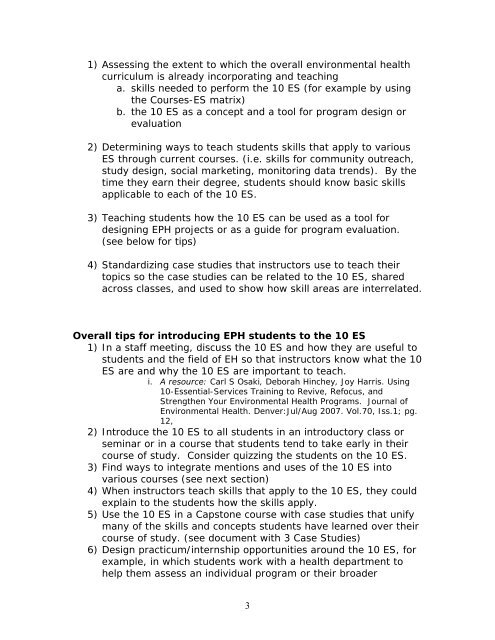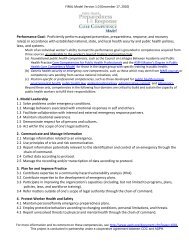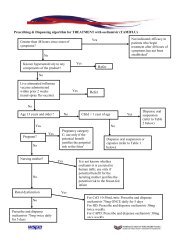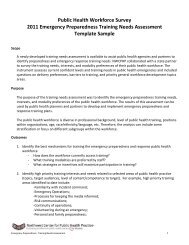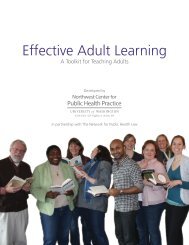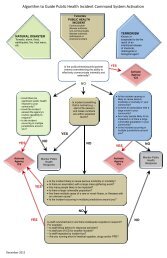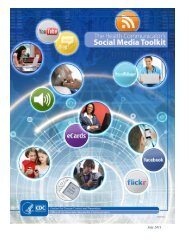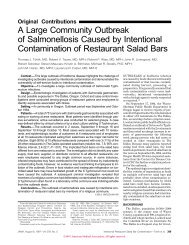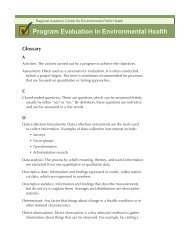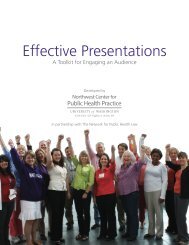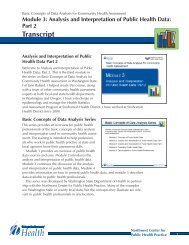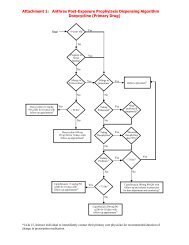Teaching the Ten Essential Services of Environmental Health: A ...
Teaching the Ten Essential Services of Environmental Health: A ...
Teaching the Ten Essential Services of Environmental Health: A ...
Create successful ePaper yourself
Turn your PDF publications into a flip-book with our unique Google optimized e-Paper software.
1) Assessing <strong>the</strong> extent to which <strong>the</strong> overall environmental health<br />
curriculum is already incorporating and teaching<br />
a. skills needed to perform <strong>the</strong> 10 ES (for example by using<br />
<strong>the</strong> Courses-ES matrix)<br />
b. <strong>the</strong> 10 ES as a concept and a tool for program design or<br />
evaluation<br />
2) Determining ways to teach students skills that apply to various<br />
ES through current courses. (i.e. skills for community outreach,<br />
study design, social marketing, monitoring data trends). By <strong>the</strong><br />
time <strong>the</strong>y earn <strong>the</strong>ir degree, students should know basic skills<br />
applicable to each <strong>of</strong> <strong>the</strong> 10 ES.<br />
3) <strong>Teaching</strong> students how <strong>the</strong> 10 ES can be used as a tool for<br />
designing EPH projects or as a guide for program evaluation.<br />
(see below for tips)<br />
4) Standardizing case studies that instructors use to teach <strong>the</strong>ir<br />
topics so <strong>the</strong> case studies can be related to <strong>the</strong> 10 ES, shared<br />
across classes, and used to show how skill areas are interrelated.<br />
Overall tips for introducing EPH students to <strong>the</strong> 10 ES<br />
1) In a staff meeting, discuss <strong>the</strong> 10 ES and how <strong>the</strong>y are useful to<br />
students and <strong>the</strong> field <strong>of</strong> EH so that instructors know what <strong>the</strong> 10<br />
ES are and why <strong>the</strong> 10 ES are important to teach.<br />
i. A resource: Carl S Osaki, Deborah Hinchey, Joy Harris. Using<br />
10-<strong>Essential</strong>-<strong>Services</strong> Training to Revive, Refocus, and<br />
Streng<strong>the</strong>n Your <strong>Environmental</strong> <strong>Health</strong> Programs. Journal <strong>of</strong><br />
<strong>Environmental</strong> <strong>Health</strong>. Denver:Jul/Aug 2007. Vol.70, Iss.1; pg.<br />
12,<br />
2) Introduce <strong>the</strong> 10 ES to all students in an introductory class or<br />
seminar or in a course that students tend to take early in <strong>the</strong>ir<br />
course <strong>of</strong> study. Consider quizzing <strong>the</strong> students on <strong>the</strong> 10 ES.<br />
3) Find ways to integrate mentions and uses <strong>of</strong> <strong>the</strong> 10 ES into<br />
various courses (see next section)<br />
4) When instructors teach skills that apply to <strong>the</strong> 10 ES, <strong>the</strong>y could<br />
explain to <strong>the</strong> students how <strong>the</strong> skills apply.<br />
5) Use <strong>the</strong> 10 ES in a Capstone course with case studies that unify<br />
many <strong>of</strong> <strong>the</strong> skills and concepts students have learned over <strong>the</strong>ir<br />
course <strong>of</strong> study. (see document with 3 Case Studies)<br />
6) Design practicum/internship opportunities around <strong>the</strong> 10 ES, for<br />
example, in which students work with a health department to<br />
help <strong>the</strong>m assess an individual program or <strong>the</strong>ir broader<br />
3


